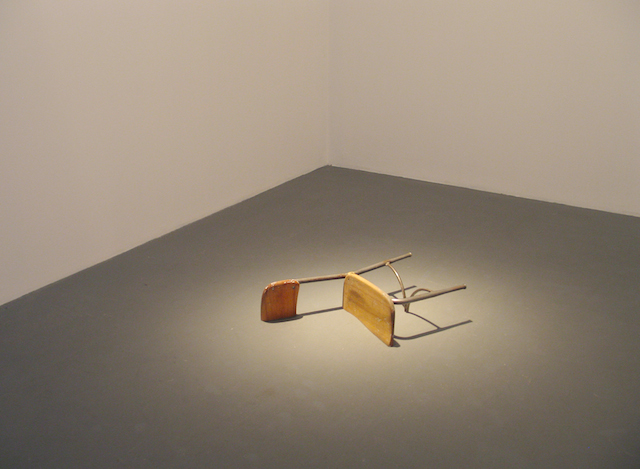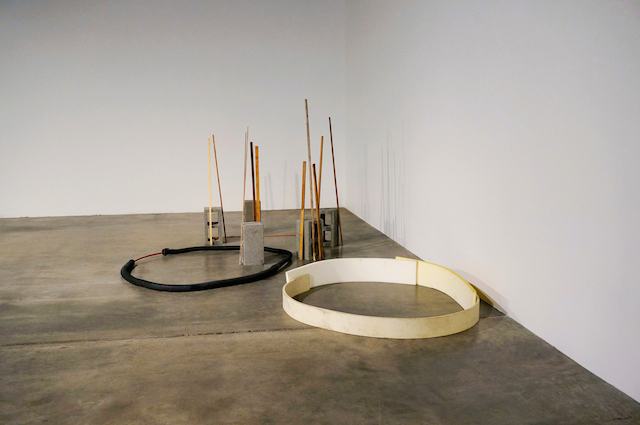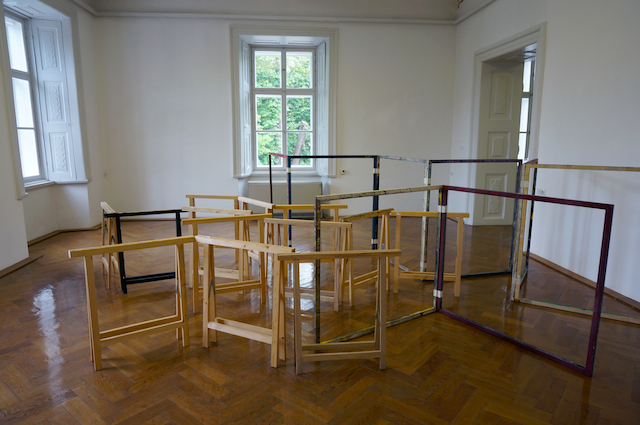Art
Space and the Body: the work of Vlatka Horvat
A ladder balances upon a wire basket and an overturned bucket, strips of wood stand propped up in clusters around cinder blocks, white gallery walls corral a herd of sawhorses. The appearance of found objects in the context of fine art is hardly surprising anymore, and they appeal to artist Vlatka Horvat for some the same reasons they appeal to many artists: they have a past, and they are rich with associations and connotations. But there’s something particular about the way Horvat uses them. Her installations are not just about objects; they are about the delicate and deliberate arranging of objects, and ultimately they are about us – about our bodies, about the relationship of our bodies to objects and space, and about how we negotiate spatial and social situations.
Horvat, who says that her work is often about the body, its presence, and its agency, comes from a performing arts background. After completing degrees in theatre and performance studies in Chicago, she began making video work and eventually started experimenting with photography, collage, and other media, almost always depicting the body in some way.
An opportunity to exhibit at The Kitchen in New York City in 2009 marked a turning point in Horvat’s work. Wanting to further investigate the question of presence, she gave herself the task of dealing with “the tenuous relationship of the body to its context” without visually depicting the body itself. The resulting installation, Or Some Other Time, shifted focus from the visually represented body to the actual body of the viewer present in the room, asking viewers to physically and mentally negotiate their relationship with everyday objects installed in unexpected ways, such as an escape ladder cut in half lengthwise and mounted out of reach, or a chair, also cut in half, turned on its side and sunk halfway into the floor, its severed edge merging with the concrete.
Since then, Horvat has continued to work with installation, further probing the relationship between the body, space, and objects. Her work is typically site specific, and she often starts with the space itself, taking clues from what is already there and altering it in some way. When working out an installation, she asks herself what the space “wants” – what can happen there, what might be the right (or wrong!) thing to do there.
At the former Geozavod building in Belgrade, for example, in the framework of the 2012 October Salon, Horvat thought of an idea for her project as she walked through the space during a site visit. She noticed that all the doors in the entire building were missing door knobs and handles, and she proposed that all of the building’s doors be removed from their hinges and relocated into a single room. She then arranged these unhinged and displaced objects back to back, forming a line of doors leaning against one another, stretching from wall to wall, across the entire width of the room. The installation, titled Door to Door, reinterpreted the function of the door, creating a barrier from something typically used to regulate passageways.
Horvat worked in a similar way at Disjecta Contemporary Art Center in Portland, OR, a space she had not visited before arriving to work on the installation. She made a list of materials and objects she wanted to work with ahead of time and then spent several days upon arriving in Portland visiting reclaim yards, recycling centers, junk depots, second-hand shops, and dumpsters around Disjecta, collecting materials to work with. Based on what she was able to find, her initial ideas and plans were revised and adjusted in response to what was available locally. In this way, the context of the city actively determined the development of the work, and her site-specific project became in a way even more site specific. Using an assortment of found items, such as a tarp, a pile of two-by-fours, a couple of wooden ladders, and some cinder blocks, Horvat created an interior landscape within the gallery space, demarcated by fence-like arrangements that invited viewers to walk into and around them, functioning simultaneously as obstacles, provisional space organizers, and openings into distinct “zones” or “territories.”
When working on an installation, Horvat spends a significant amount of time in the space testing various combinations of objects and building possible arrangements. An earlier work poignantly illustrates this process: in the performance This Here and That There, Horvat trudges through water for eight hours, arranging and rearranging fifty chairs, maneuvering them into a perfect configuration only to dismantle it as soon it’s completed and start over again. Although Horvat may not physically appear in much of her current work, the careful selection and placement of objects announces her presence. Through her meticulous arrangements, she at once guides viewers and steps back, an unseen mediator maintaining a sense of integrity and wholeness that underlies the tension created between body and space.
Vlatka Horvat’s solo exhibition According to Plan is on view at Mmc Luka in Pula, Croatia until June 16, 2014. Horvat will be participating in the group exhibition Notes on Undoing, curated by Branka Benčić in partnership with Ikon Arts Foundation, at Garis & Hahn in November 2014.
Written by Elaine Ritchel
Images courtesy of the artist










